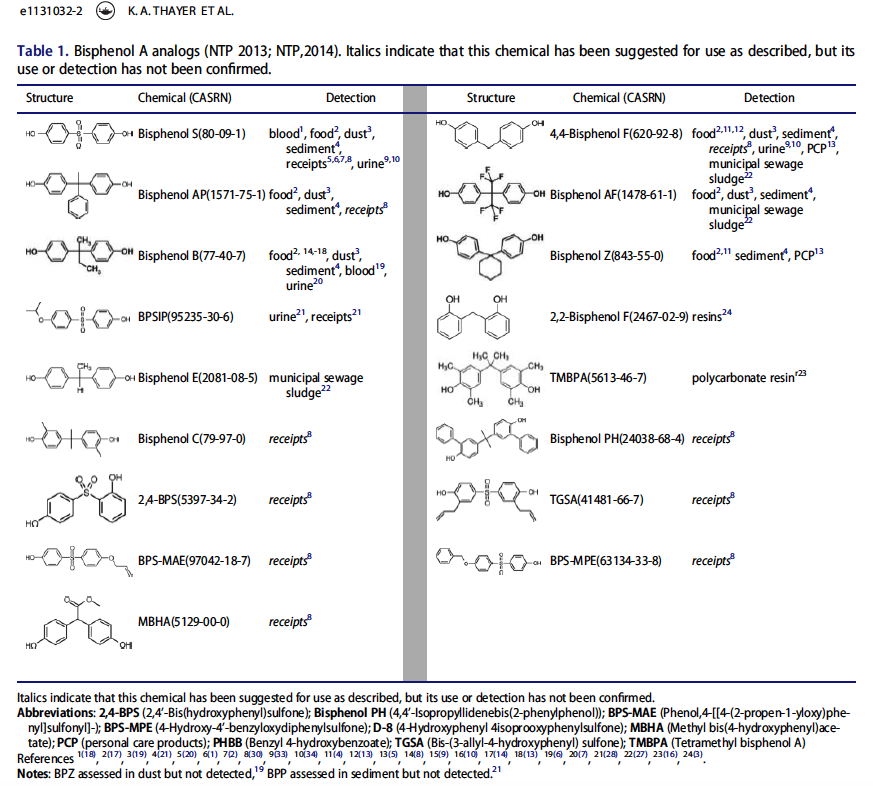BPA substitute Tritan found to cause estrogenic activity:
- Migration of plasticisers from Tritan ™ and polycarbonate bottles and toxicological evaluation
- Estrogenic chemicals often leach from BPA-free plastic products that are replacements for BPA-containing polycarbonate products
- Chemicals having estrogenic activity can be released from some bisphenol A-free, hard and clear, thermoplastic resins
- UPDATE: This search at Google Scholar shows scores and scores of articles updating the older links, above.
In addition, the number of variations (analogues) of Bisphenol A is growing. The developments are driven by the marketing desire to brand a product “BPA free.”
There are now at least 24 and all have been found to rival BPA’s harmful nature..
According to the National Toxicology Program which looked at 24 analogues and found: “BPA analogues that are potential replacements for BPA have biological activity within the range of activity observed for BPA.”
Other published research also indicates that these analogues are just as bad for health as old-school BPA.
- Two studies add to the evidence that replacements for the plastic additive affect cells and animals in the same, untoward ways as bisphenol A.
- BPA substitutes may be just as bad as the popular consumer plastic
- Estrogenic chemicals often leach from BPA-free plastic products that are replacements for BPA-containing polycarbonate products.
- Most Plastic Products Release Estrogenic Chemicals: A Potential Health Problem That Can Be Solved
- From BPA to its analogues: Is it a safe journey?
The BPA chemical arms race is analogous to the whack-a-mole way that illegal synthetic drugs evade law enforcement
Because chemical companies have the financial resources to keep on concocting new formulas faster than scientific research can keep up, the word on the dangers of the new variations also lags.
“Clearly environmental health research cannot keep ahead, or even keep up with the rate and number of new materials that modern industry is introducing into commerce” — Bisphenols: More unnecessary surprises — a study of 16 of the 24 known analogues (see below).
This ad-free article is made possible by the financial support of the
Center for Research on Environmental Chemicals in Humans: a 501(c)(3) non-profit.
Please consider making a tax-deductible donation for continued biomedical research.
In many ways, this whack-a-mole — “chemical arms race” — is like that for illegal synthetic drugs.
- Synthetic Drugs Are Multiplying Too Fast for Regulators to Outlaw Them
- There are so many new designer drugs that governments can’t ban them fast enough
Every time a synthetic drug is outlawed, drug makers tweak the formula by adding (or subtracting) a few atoms without changing the psychoactive effects. This makes it a “new” formula which requires money and legislation to change.
Sometimes chemical companies are simply dishonest about their plastics
The following colored text is a direct quote with the following modifications: Paragraph spacing has been added for readability. Emphasis has been added in one indicated instance.
“Often plastics are labeled BPA free, but they can contain a derivative of BPA called BPS (bisphenol S), which may be as dangerous as BPA.
“Investigations about the effect of BPS on animals have demonstrated impact congenic to those of BPA.
“Similarly, a BPA/BPS substitute known as Tritan is a plastic marketed as BPA free. Tritan is a clear, sturdy, heat-resistant plastic made from triphenylphosphate, which is more estrogenic than BPA [Emphasis added]. There is leaching here too.
“One example of the use of Tritan is coffee take-out cups.
“BPA breakdown products also bind to the estrogen receptor, with a greater affinity (ka) than BPA itself. Not surprisingly, there have been many disorders linked to BPA and its derivatives, from autism to zebrafish hyperactivity, as many researchers try to link a cause and effect to research grants. Until more conclusive evidence is produced, only the aforementioned confirmed effects should be accepted.”
“The effect of BPA may last for generations (transgenerational inheritance).”
Source: Steven Ackerman, William Horton, Chapter 2.4 – “Effects of Environmental Factors on DNA: Damage and Mutations,” Editor(s): Béla Török, Timothy Dransfield, Green Chemistry, Elsevier, 2018, Pages 109-128, ISBN 9780128092705, https://doi.org/10.1016/B978-0-12-809270-5.00005-4. (http://www.sciencedirect.com/science/article/pii/B9780128092705000054)
Tritan’s manufacturer went to dishonest and unethical lengths to hide the toxic issues
- Eastman Chemical’s Tritan plastic Wins False & Deceptive “Two-Fer”
- Toxic Science: Fiddling Facts For Profit & Legal Leverage
- Predictable Outcomes: How To Skew Experiment Design To Produce Predictable Results
- Covertly Stretching “Peer Review” Until It Breaks
- Hoodwinking Whole Foods, Stonewalling Thermos
- Scientific Publication Fraud: Laundering Money & People
A handful of studies indicate that Tritan does not leach estrogenic compounds. However, given the provable dishonesty and subterfuge of its manufacturer to subvert the peer-review process (see links above), the credibility of those studies must be viewed with skepticism
Further reading
- BPA-Free Isn’t Always Better: The dangers of BPS, a BPA substitute
- BPA substitutes may be just as bad as the popular consumer plastic
- Chemical in BPA-Free Products Linked to Irregular Heartbeats
- New research shows that BPA-free plastic might still be harmful
- BPS, a popular substitute for BPA in consumer products, may not be safer
- New York State looks to expand BPA ban to substitution chemicals
- How many analogues of Bisphenol A?

Comments are closed.